Americans are reluctant to part with some old media and some new, but traditional print media don’t fare well.
With the proliferation of communications devices and services, it is worth examining the relative strength of preferences among Americans for their gadgets and services. Although the technologies by which people receive and process information may be converging, there is no reason to think that people’s attitudes about them are monolithic across technologies or the groups of technology consumers we have identified.
Americans are reluctant to part with some old media and some new, but traditional print media don’t fare well.
We asked respondents how difficult it would be to give up the following communication and media items: telephone, cell phone, TV, cable TV, computer, Internet, email, personal digital assistant, newspaper, and magazine. In looking collectively at the responses, the old media fare rather well. The wireline telephone at home tops the list – nearly two-thirds (64%) of all Americans say it would be very hard to give up their telephones. Television comes in second with about half (48%) of Americans saying it would be very difficult to do without TV.
Next, in order of preference, comes a group of new media gadgets or services. Anywhere from 36% to 40% of users would find it very hard to give up the computer, the Internet, cell phone, and cable TV. The PDA, however, is something of an outlier: only a minority of those who have it say would be hard to part with; only 24% of PDA users say it would be very difficult to give it up.
Americans find several traditional media least important to them. Only 19% of Americans say they would find it hard to give up the newspaper and only 13% say it would be difficult to give up their favorite magazine.
Media preferences vary among the eight categories of technology users.
Young Tech Elites: attached to new media
For the Young Tech Elites, the pattern of media preference is essentially the mirror image of the national average. Young Tech Elites would find it harder to give up their wireline phones than their cell phones. By a large margin, they would find it more difficult to give up their computers or the Internet than their TVs or their cable subscriptions. Nearly three-quarters (74%) of the Young Tech Elites say it would be very hard to give up their computers, and 68% say the same about the Internet. By contrast, 48% say it would be very hard to do without TV and 40% say that for cable TV. Suggestive of how Young Tech Elites communicate with others, about as many say it would be very hard to give up email as say that about the telephone (57% for email, 56% for telephone). And as many say it would very hard to give up the cell phone (58%) as say that about email or the telephone. Finally, the Young Tech Elites do not value old media highly – only 12% say it would be difficult to give up the newspaper and 11% say the same about magazines.
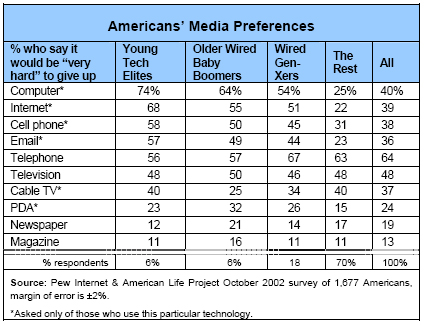
Wired Older Baby Boomers: wed to computers
While new media is usually associated with youth, it is surprising to find new media looming very large for some older Americans. For Wired Older Baby Boomers, the computer is the technology that would be hardest to give up, with 64% saying it would be very difficult to be without a computer. Bunched behind the computer are both the telephone and the Internet, with 57% and 55%, respectively. A bit farther back comes the cell phone, the Internet, and TV, with about half of Older Wired Baby Boomers saying in each case that it would be very difficult hard to give these up. The PDA even occupies an important space for aging boomers; 32% say it would be very hard to give theirs up, well above the rate for the Young Tech Elites (23%) and the national average (24%). For aging boomers, the PDA is more important to them than cable TV, as 25% say they would have a very hard time doing without cable.
Wired GenXers: attached to wireline telephones
For Wired GenXers, the old media–new media distinction is not quite as clear. By a large margin, the telephone is the item that Wired GenXers would find hardest to do without; 67% say this, with the computer coming in next, with 54% saying it would be very hard to do without that. Perhaps because they are at a more stationary time of life, with kids and (relative to the Young Tech Elites) more stable job situations, the Wired GenXers highly value the wireline telephone. Still, Wired GenXers value the Internet more than TV, although they seem less attached to email than the other two tech elite groups.
Older and younger tech elites differ in the way they gather news and seek content online.
The primacy of new media for the Young Tech Elites shows up further when looking at newsgathering and who pays for online content. Not many Internet users pay for online content – only 8% – but the Young Tech Elites and Wired GenXers are more likely to do this than any other group (13% of each group). Older Wired Baby Boomers, by contrast, come in at about average with 9%. The greater tendency among the Young Tech Elites and Wired GenXers to pay for content is consistent with their preference for new media newsgathering. The Young Tech Elites are nearly as likely on the average day to get news online as from a newspaper; 39% get news online on the average day while 45% read a newspaper.
The Older Wired Baby Boomers, by contrast, are more likely to read the paper on the average day than to go online for news, by a 57% to 49% margin. They are more likely to both get news online and from a newspaper on the typical day (29% do) than the Young Tech Elites (21%) or Wired GenXers (19%) do. Older people tend to be more habitual news hounds than young people, and these findings indicate that the Older Wired Baby Boomers supplement newspaper reading with online sources. The Young Tech Elites and Wired GenXers, by contrast, seem more likely to turn first to the online world for news and, to a modest degree, to pay for it.
For the remaining groups – about 70% of the population – technology and media preferences line up as one would expect. The telephone and TV rank as items people in these groups say would be hardest for them to give up. In general, the older groups value the telephone the most (76% say it would be very difficult to give up the telephone) followed by the TV (55% say it would be very hard to give up their TVs).
People’s information technology use often reflects their life stage and their relative mobility.
Some of the differences in relative preferences across the groups of tech elite are likely due to people’s stage of life. Young people, especially students, are more mobile and have less entrenched consumption habits than older people. The cell phone fits right into this lifestyle. In thinking about the cell phone versus the wireline phone, the choice for many of these people may be easy, especially for students with access to the Internet and other media subsidized by their colleges. The Older Wired Baby Boomers are overlaying new media onto established habits of information consumption. Thus, it is no surprise that the telephone continues to occupy a prominent place for this group, though it remains notable that the computer and Internet have risen to a high level importance for Older Wired Baby Boomers.
A good deal of the contemporary discussion about media focuses on convergence – speculation that TV will be piped to the computer via the Worldwide Web, that TV will provide Web access, and that each might be available on the cell phone, PDA, or wireless laptop. While the devices and services may already (or will soon) provide the same information in similar formats, the findings above, particularly for the Young Tech Elites, suggest that the means of delivery are important.
The technology elite take a hands-on approach to their online experience.
With the emergence of an elite group of technology users, it is understandable that these people actively manage their technology experience. When it comes to the Internet, the technologically sophisticated – especially the Young Tech Elites – exhibit discriminating tastes in choice of Internet service provider and the choice of homepage that is first displayed when they click on their Web browsers. This has obvious competitive implications for ISPs, as the behavior of the Young Tech Elites indicates that ISPs will have to work diligently to retain these high-end customers. There are also implications for policymakers and business models with respect to rules that govern the degree of control ISPs may have over online content, such as users’ homepages.
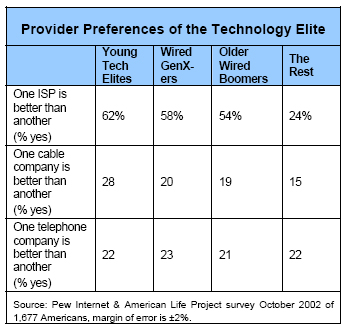
Looking specifically at whether Internet users think one ISP is likely to be better than another, there are noticeable contrasts between the three tech elite groups and other Internet users who are not experienced and heavy users. Fully 62% of the Young Tech Elites says they think one ISP may be better than another and all three tech elite groups are more than twice as likely than other groups to think that one ISP is better than another. Differences between the tech elite and non-elite in perception about the variation in quality across telephone or cable companies are not that great, although the Young Tech Elites are more likely than everyone else to perceive differences in cable companies.
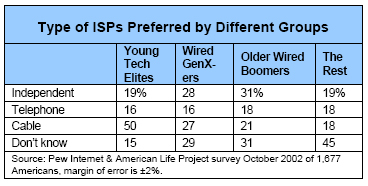
We asked all Internet users whether they would prefer an independent ISP, one run by a phone company, or one run by a cable company. Fully 50% of the Young Tech Elites said they would prefer to have their Internet service come from a cable company, more than twice the rate for the non-tech elite. This is mainly because Young Tech Elites are more likely than average to have home broadband connections and about two-thirds of home broadband users connect by cable modems.
Tinkering with the interface and switching ISPs
The evidence indicates that most Internet users (by modest margins) have not changed ISPs and continue to have the homepage provided by their ISPs come up on their screens when they log on. But there are sharp differences between the tech elite and the non-tech elite.
Let’s first look at the process people undergo in switching (or not) the homepage provided by their ISP. Among all Internet users, most – 57% – say that the homepage that displays on their browser is the one provided by the ISP. About 4 in 10 (42%) of Internet users (and 30% of the non-tech elite) have made the choice to switch the homepage they see when they log on. Among those who have not switched the homepage, many do not know how to switch the ISP-provided homepage – 40% of all Internet users can do this or 38% of the non-tech elite. Looking at the numbers differently, about one-third (34%) of all Internet users actively choose to have ISP-chosen homepage display on their browsers; the rest have either switched by choice or don’t know how to switch.
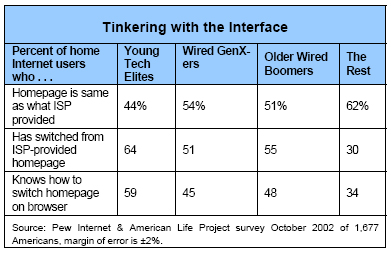
For the three groups that comprise the tech elite, however, the numbers line up very differently. Fully 64% of the Young Tech Elites switch the homepage provided by their ISP, well above the 42% average for all users and more than twice the rate of 30% for the non-tech elite. Fully 59% of non-switchers know how to change the page, approaching twice the rate of non-tech elite (34%). For the Young Tech Elites, just 18% actively choose to display the homepage that their ISP provides them. The “sign on” Web page, which ISP may consider an important piece of real estate to branding their presence with customers, is not that important for the Young Tech Elites —about half as important as to the average Internet user.
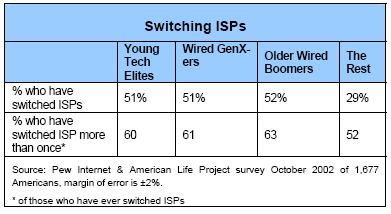
Looking at whether people change ISPs, 29% of non-tech elite Internet users have switched ISPs at one point, and among switchers, 52% have switched multiple times. For all Internet users, 41% have changed ISPs at some point, and 59% have done so more than once.
The story is reversed for the three groups in the tech elite. Half (51%) has switched ISPs at one point, 61% of switchers having done so more than once. Although the tech elite’s switching behavior is mostly attributable to their length of time online, some of it is attributable to the kind of people these users are.
As the most ardent personal information processors, Young Tech Elites are disposed toward tinkering with their online experience, whether in the choice of ISP or homepage. The ability to choose one’s own homepage matters to most of the Young Tech Elites. However, for Internet users at large, whether by choice or lack of knowledge, most stay with the homepage ISPs provide, suggesting that this is fairly valuable piece of real estate on the Web.
The number of wireline telephones has decreased for the first time in history.
A concern among traditional providers of wireline telephone service is that new technology services will undercut their business. In fact, there is evidence that this is true: the number of wireline telephones in service in the United States is, for the first time in history, declining. Telephone penetration in the United States seems at a saturation point, with 95% of Americans having a phone in the home. About one-third of all American households have more than one telephone line, whether that line is for a fax machine, Internet access, a home office, or a teenager. This figure has remained roughly the same since early 2001. The era of adding phone lines – whether it’s for the teenager or the Internet connection – seems to have passed with the advent of cell phones and high-speed connections. The result, according to the FCC, has been a decrease in the number of wireline telephones in the United States by 5 million, or a 3% drop.
Our findings are not inconsistent with the notion that the proliferation of communications means and devices may result in a decrease in the number of telephone lines coming into the home. Overall, 3% of the respondents who have a cell phone said that they have actually cancelled a home telephone line with the intent of using a cell phone as their means of telephonic contact with others. (Because only cell phone users were asked this question, this means 2% of all respondents have cancelled a home telephone line.) Of cell phone users who have not cancelled their wireline telephone, 7% have very seriously considered giving up their home telephone line, with another 14% having somewhat seriously considered this.
Among the Young Tech Elites, there is evidence that this high-tech cohort is ready for a “one provider” solution that may, for some at least, result in the elimination of traditional telephone service. About 9% of the Young Tech Elites with cell phones (or 7% of all Young Tech Elites) have cancelled a wireline phone in favor of their cell phones; although still small, it is higher than the national average of 3%.
In light of this FCC’s ruling about the portability of telephone numbers, one can easily imagine an accelerating trend to do away with the home telephone line. This is especially true for the three groups that make up the tech elite. Tech elites are more likely to have broadband than others, use a cable company for high-speed service, and, especially for Young Tech Elites, prefer a cable company for such service. Among tech elite households who report that they have one telephone line currently, 27% say they have “very” or “somewhat” seriously considered canceling it because of a cell phone. For nontech elite households, that number is 19% among single line households. Looking at the data differently, one could imagine anywhere from 7% to 12% of U.S. households not having a wireline telephone if people follow through on their “serious” consideration of canceling a line.%%FOOTNOTE%% The FCC’s new rule makes it much easier to do this.
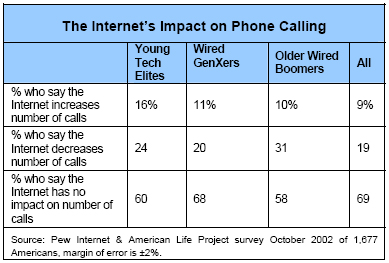
Other indicators portray a shift away from wireline phone service as a way to connect with people. Although most of the Young Tech Elites (59%) say the Internet has not affected the number of phone calls they make from home, 25% says that the Internet has decreased the amount of phone calls they make, with 15% saying the Internet has increased the amount of phone calls they make. A few seem to be making calls on the Internet instead of the telephone; one in six (16%) of the Young Tech Elites have made a phone call via the Internet (twice the 8% average).
Finally, the Young Tech Elites seem disposed to a “one provider” solution no matter what the Net’s impact on their phone calling. Fully 41% currently pay for their Internet access in conjunction with another service, such as cable or telephone, well above the 29% figure for all home Internet users.
If the Young Tech Elites are a harbinger of future phone calling patterns, this suggests that there are some risks for telephone companies in the offing. One can easily imagine a significant share of Young Tech Elites doing without a home telephone in the traditional sense, but rather using a cable company for the high-speed Internet connection and cable TV service, using the cell phone for telephone conversations (and perhaps text messaging), and occasionally placing a phone call online. The wireline phone doesn’t fit into this portrait of how communications needs are met for the Young Tech Elites. And, as noted, this group shows a preference for paying their communications bill to one company and most prefer the cable company for an ISP.
The technology elite have high-speed connections.
One of the many distinctive characteristics of the technology elite is that they have highspeed Internet access at home. As of October 2002, nearly one-third (29%) of the technology elite – that is, the Young Tech Elites, Wired GenXers, and Wired Older Baby Boomers – have broadband access at home, compared with 17% of non-tech elite Internet users. As noted earlier, the Young Tech Elites are disproportionately heavy broadband users, as 39% of them have high-speed home connections.
We asked all home broadband users several questions about their transition from dial-up to broadband and what they value about their high-speed connection. Specifically, we asked whether users switched ISPs when they moved to broadband, whether they cancelled a telephone line upon getting broadband at home, and whether speed or the “always on” connection matters more to them.
Among all broadband users, 16% cancelled a phone line once their home broadband connection was installed, a figure that is about the same for the tech elite and non-tech elite alike. Most (61%) broadband users also switched ISPs after getting broadband at home. And most (76%) say they value the connection speed more than the “always on” character of the connection; 17% say they like “always on” the most while 4% like them both equally. The technology elite make up about one-third of the general population but make up two-thirds of broadband users. Among this group, the only notable difference came in switching ISPs. Fully 70% of those in one of the three tech elite groups switched ISPs upon getting broadband at home, while 44% of non-tech elite broadband users did this.
AOL remained the market leader among ISPs.
In addition to probing people’s attitudes about choice and behavior vis-à-vis ISPs, we gathered basic market data about the ISPs to which Internet users subscribe. As of October 2002, 28% of all U.S. Internet users subscribed to America Online (AOL). AOL is clearly the market leader, with all competitors registering in the single digits. MSN comes in second with 8% of Internet users, followed by AT&T Worldnet with 4% and Earthlink/Mindspring with 3%. The scattering of independent ISPs make up the preponderance of the balance, with 25% of Internet users falling into the “Other” category for ISP subscribership.
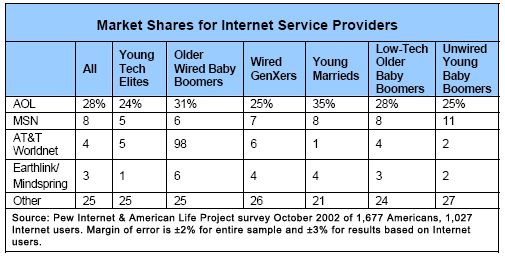
As for why users chose a particular ISP, there is a similar scatter of reasons given. About one in six (17%) say they chose their ISP because of a promotional offering, one in seven (14%) said they chose their current ISP because they thought the service would be better than that provided by their previous ISP. One in nine (11%) said that the price was attractive to them, and only 4% said it was the only ISP available to them; 15% cited other reasons.
Looking across the groupings of technology users reveals a few interesting variations. The Young Tech Elites seem a bit less inclined to subscribe to AOL than other users (24% versus 28%). This group strikes a clear contrast with their less-wired counterparts in the same age group, the Young Marrieds who have a modest amount of personal information technology. More than one–third (35%) of this latter group use AOL. In an interesting cross current, the other segment that has a heavy orientation toward tech gadgets – Wired Aging Baby Boomers – is somewhat more disposed to AOL than others; 31% of this group uses AOL to connect to the Internet.
Overall, Americans have a positive attitude toward technology but a few feel overwhelmed by information.
Americans are typically very optimistic when thinking about technology, with 5 in 8 (62%) of all Americans saying they generally like computers and technology, and twothirds (67%) saying they like the abundance of information available today. Those who have the most tech goods and services are the ones who feel least burdened by information and have the most positive attitudes about technology. For the Young Tech Elites, the Older Wired Baby Boomers, and Wired GenXers, optimism about technology is very high, with 80% saying they like computers and technology. At the other end of the spectrum, the older less-wired groups – the Unwired Young Baby Boomers and the Low-Tech Elderly – have somewhat pessimistic views of technology and the wealth of information available today. A slight minority of them (48%) expresses a positive attitude about computers and technology.
On the other side of the coin, only one in five Americans (21%) say they feel overloaded by too much information. Very few (10%) of the Young Tech Elites feel this way, while 35% of those in the groups of older women who modestly use information goods and services say this. As for how they see technology affecting their lives, 56% of people in the three groups of elite tech users say that technology gives them more control over their lives. Those who have less technology – the two groups of predominantly older women – are less likely to say technology gives them more control of their lives (33% say this). This cuts two ways. It is likely that technology is giving people the wherewithal to better control their lives; it is also likely that people who have a greater amount of control over their lives are the ones who, for whatever reason, are heavy technology users.




